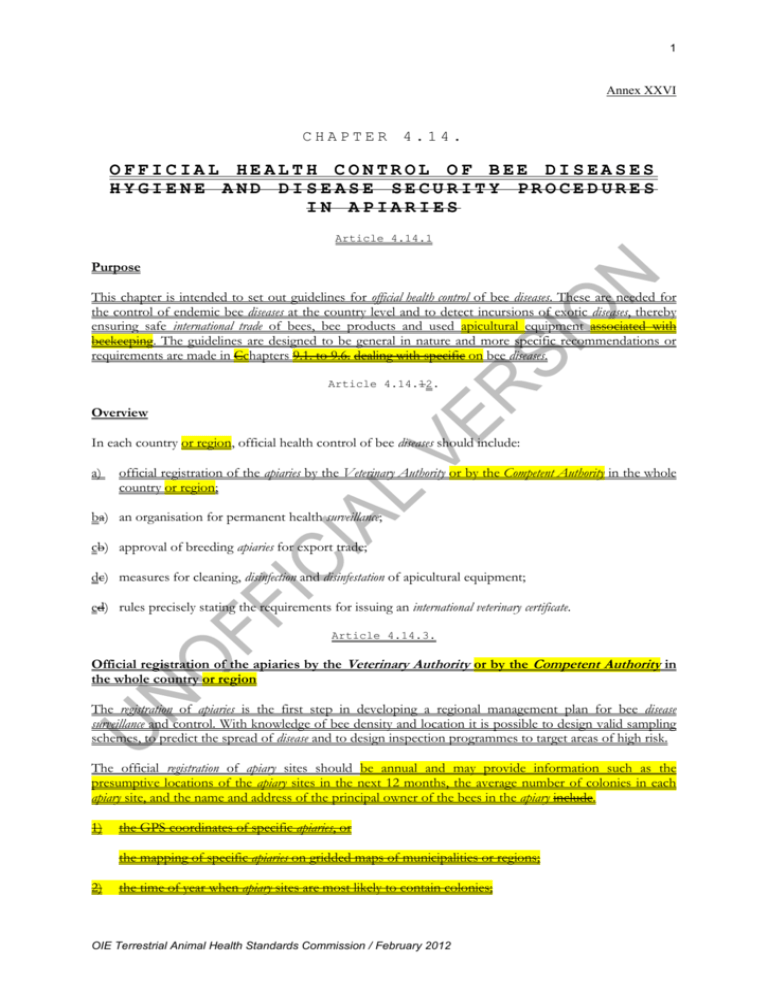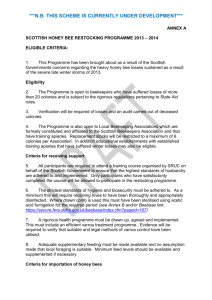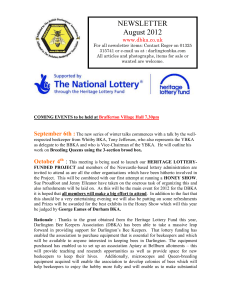UNOF VERS_Annex XXVI_CH_4_14
advertisement

1 Annex XXVI CHAPTER 4.14. OFFICIAL HEALTH CONTROL OF BEE DISEASES HYGIENE AND DISEASE SECURITY PROCEDURES IN APIARIES Article 4.14.1 Purpose This chapter is intended to set out guidelines for official health control of bee diseases. These are needed for the control of endemic bee diseases at the country level and to detect incursions of exotic diseases, thereby ensuring safe international trade of bees, bee products and used apicultural equipment associated with beekeeping. The guidelines are designed to be general in nature and more specific recommendations or requirements are made in Cchapters 9.1. to 9.6. dealing with specific on bee diseases. Article 4.14.12. Overview In each country or region, official health control of bee diseases should include: a) official registration of the apiaries by the Veterinary Authority or by the Competent Authority in the whole country or region; ba) an organisation for permanent health surveillance; cb) approval of breeding apiaries for export trade; dc) measures for cleaning, disinfection and disinfestation of apicultural equipment; ed) rules precisely stating the requirements for issuing an international veterinary certificate. Article 4.14.3. Official registration of the apiaries by the Veterinary Authority or by the Competent Authority in the whole country or region The registration of apiaries is the first step in developing a regional management plan for bee disease surveillance and control. With knowledge of bee density and location it is possible to design valid sampling schemes, to predict the spread of disease and to design inspection programmes to target areas of high risk. The official registration of apiary sites should be annual and may provide information such as the presumptive locations of the apiary sites in the next 12 months, the average number of colonies in each apiary site, and the name and address of the principal owner of the bees in the apiary include. 1) the GPS coordinates of specific apiaries, or the mapping of specific apiaries on gridded maps of municipalities or regions; 2) the time of year when apiary sites are most likely to contain colonies; OIE Terrestrial Animal Health Standards Commission / February 2012 2 Annex XXVI (contd) 3) the average number of hives expected in a given apiary; 4) the name and address of the principal owner of the bees in the apiary. The main apiary locations (places where the bee hives are located the longest time in the year) should be registered first, followed as far as possible by the seasonal apiary locations. Article 4.14.24. Organisation for permanent official sanitary surveillance of apiaries Veterinary Authorities of countries are requested to regulate the organisation for permanent official sanitary surveillance of apiaries. Permanent official sanitary surveillance of apiaries should be under the authority of the Veterinary Authority and should be performed either by representatives of this Authority or by representatives of an approved organisation, with the possible assistance of bee-keepers specially trained to qualify as ‘health inspectors and advisers’. The official surveillance service thus established should be entrusted with the following tasks: 1. visit apiaries: a) annual visits to an appropriate sample of a representative number of apiaries, based on the estimated risk in the whole country or region, during the most appropriate periods for the detection of diseases; b) additional unexpected visits to apiaries may be where breeding or transport operations are carried out for specific purposes including trade or transfer to other regions, or any other purpose whereby diseases could be spread, as well as to apiaries located in the vicinity; c) special visits for sanitary surveillance to sectors where breeding apiaries have been approved for export purposes; 2. collect the samples required for the diagnosis of contagious diseases and despatch them to an official laboratory; the results of laboratory examinations must should be communicated within the shortest delay to the Veterinary Authority; 3. apply hygiene measures, comprising, in particular, treatment of colonies of bees, as well as disinfection of the equipment and possibly the destruction of affected or suspect colonies and of the contaminated equipment so as to ensure rapid eradication of any outbreak of a contagious disease. Article 4.14.35. Conditions for approval of breeding apiaries for export trade Veterinary Authorities of exporting countries are requested to regulate the conditions for approval of breeding apiaries for export trade. OIE Terrestrial Animal Health Standards Commission / February 2012 3 Annex XXVI (contd) The apiaries must should: 1. be situated in the centre of an area defined as follows and in which: a) no case of varroosis has been reported for at least the past 2 years within a radius of 50 kilometres; b) no case of any other contagious disease of bees included in this Terrestrial Code has been reported for at least the past 8 months within a radius of 5 kilometres; 21. have received, for at least the past 2 years, visits by a health inspector and adviser, carried out at least once a year using a risk-based approach at least 3 two times a year (in spring, during the breeding period and the most appropriate periods for detection of listed diseases of bees in autumn). During these visits, there should be a , for the systematic examination of at least 10% of the hives containing bees and of all the used apicultural equipment (especially stored combs), and for the collection of samples to be sent to an official laboratory and, depending on the situation of the importing and exporting countries, no positive results were reported to the Veterinary Authorities for the relevant bee listed diseases of bees included in the Terrestrial Code; 2. be regularly systematically be sampled within seven days of shipment and, depending on the epidemiological situation of the importing and exporting countries, and found free from for the relevant bee listed diseases of bees included in the Terrestrial Code. To achieve this, a statistically valid number of bee colonies should be examined by any method complying with the relevant chapters of the Terrestrial Manual. Bee-keepers must should: 3. immediately notify the Veterinary Authority of any suspicion of a contagious listed disease of bees in the breeding apiary and in other apiaries epidemiologically linked apiaries in the vicinity; 4. not introduce into the apiary any bee (including pre-imago larval stages) or used apicultural equipment material or product originating from another apiary unless that apiary is recognised by the Veterinary Authority to be of equivalent or higher health status or the used apicultural equipment or product has been treated in agreement with a procedure described in the relevant chapters of the Terrestrial Code health control has been previously performed by theVeterinary Authority; 5. apply special breeding and despatch techniques to ensure protection against any outside contamination, especially for the breeding and sending of queen-bees and accompanying bees and to enable retesting in the importing country; 6. collect at least every 10 30 days, during the breeding and despatch period, appropriate samples from breeding material, brood-combs, bees (including possibly separately raised accompanying bees) queen-bees and or queen-bees bees (including possibly separately raised accompanying bees), to be sent to a an official laboratory and all the positive results officially reported to the Competent Authority. Article 4.14.46. Conditions for sanitation and disinfection or disinfestation of apicultural equipment Veterinary Authorities of exporting countries are requested to regulate the use of products and means for sanitation and disinfection or disinfestation of apicultural equipment in their own country, taking into account the following recommendations. OIE Terrestrial Animal Health Standards Commission / February 2012 4 Annex XXVI (contd) 1. Any apicultural equipment kept in an establishment which has been recognised as being affected with a contagious disease of bees shall should be subjected to sanitary measures ensuring the elimination of pathogens. 2. In all cases, these measures comprise the initial cleaning and scraping of the equipment, followed by sanitation or disinfection or disinfestation depending on the disease concerned. 3. The kind of equipment (hives, small hives, combs, extractor, small equipment, appliances for handling or storage) shall also be taken into account in the choice of procedures to be applied. 34. Any Infected infested or contaminated equipment which cannot be subjected to the abovementioned measures must should must should be destroyed, preferably by burning. Any equipment in bad condition, especially hives, as well as larvae in combs affected with varroosis, American foulbrood or European foulbrood, must should be destroyed by burning. 45. The products and means used for sanitation and disinfection or disinfestation shall should be accepted recognised as being effective by the Veterinary Authority. They shall should be used in such a manner as to exclude any risk of contaminating the equipment which could eventually affect the health of bees or adulterate the products of the hive. 6. When these procedures are not performed, the products shall be kept away from the bees and any contact with apicultural equipment and products must should be prevented. 7. Waste water from the cleaning, sanitation and disinfection of apicultural equipment shall be kept away from the bees at all times and disposed of in a sewer or in an unused well. Article 4.14.57. Preparation of the international veterinary certificate for export This certificate covers hives containing bees, swarms, consignments of bees (worker bees or drones), queen bees (with accompanying bees), brood-combs, royal cells, used apicultural equipment and bee products, etc. This document shall should be prepared in accordance with the model contained in Chapter 5.10. and taking into account the specific-disease Cchapters 9.1. to 9.6. related to on bee diseases. -------------Text deleted OIE Terrestrial Animal Health Standards Commission / February 2012







